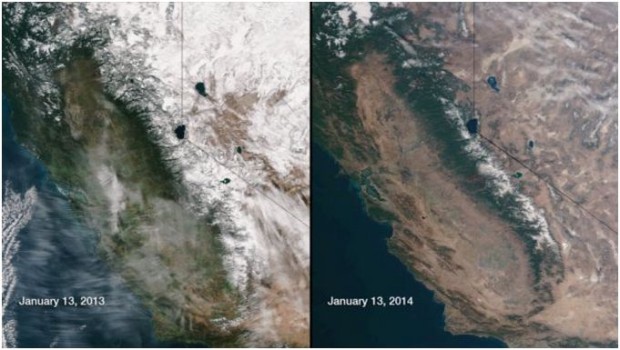Sometimes we forget that Los Angeles is really one barren-ass coastal dessert whose paradise-like nature is heavily reliant on water supplies imported from hundreds of miles away.
And guess what, with our rain/snow fall levels at record lows (see comparison of California snow levels year-to-year from satellite map below), it’s up to us to become our own water-saving super heroes and help fight off that dastardly villain known as drought.
Funny thing is a lot of these changes (timing your showers, checking leaky faucets, etc..) are so mundane I strongly believe that after a week or two of implementation of just a few key habits, we’d hardly even notice the annoyance at all.
And while maybe (likely) you can’t do all 77, even if you just hand pick one or two to make a concerted effort on, you’ll be making enough of difference to help stem the tide of our water shortage, and be of benefit to the entire community.
In short: Don’t be a water hog.
Here’s the list.
INDOOR WATER SAVING TIPS
1. If you wash dishes by hand, don’t let the water run.
2. Designate a single glass for water drinking each day. Means less glasses to wash per day.
3. Soak pots and pans instead of letting the water run while you scrape them clean.
4. Whenever possible, avoid using the garbage disposal. Scrape food off plates and into trash instead.
5. Wash your fruits and vegetables in a pan of water instead of running water from the tap.
6. Don’t use running water to thaw food. For water efficiency and food safety, defrost food in the refrigerator.
7. Install an instant water heater near your kitchen sink so you don’t have to run the water while it heats up. This also reduces energy costs.
8. Keep a pitcher of drinking water in the refrigerator instead of running the tap. This way, every drop goes down you and not the drain.
9. If you accidentally drop ice cubes, don’t throw them in the sink. Drop them in a house plant instead.
10. Collect the water you use while rinsing fruit and vegetables. Use it to water house plants.
11. When doing laundry, match the water level to the size of the load.
12. Remember that washing in cold water saves water and energy, and helps your clothes retain their color.
13. When shopping for a new washing machine, compare resource savings among Energy Star models. Some can save up to 20 gallons of water per load.
14. Have a plumber re-route your greywater to trees and plants rather than the sewer line. Check with your city and county for codes.
15. If your shower fills a one-gallon bucket in less than 20 seconds, replace the shower-head with a WaterSense® labeled model.
16. Shorten your shower time. Each minute you shorten your daily shower could means up to a 100 gallons of water per month saved.
17. Test your toilet for leaks at least once a year.
18. Put food coloring in your toilet tank. If it seeps into the bowl without flushing, there’s a leak. Fix it and start saving gallons.
19. When running a bath, plug the bathtub before turning on the water. Adjust the temperature as the tub fills.
20. Upgrade older toilets with water-saving WaterSense® labeled models. If your toilet was installed before 1992, purchasing a WaterSense® labeled toilet can reduce the amount of water used for each flush.
21. If your toilet flapper doesn’t close properly after flushing, replace it.
22. Use a WaterSense® labeled showerhead. They’re inexpensive, easy to install, and can save you up to 750 gallons a month.
23. Turn off the water while you brush your teeth and save up to 4 gallons a minute. That’s up to 200 gallons a week for a family of four.
24. Consider buying a dual-flush toilet. It has two flush options: a half-flush for liquid waste and a full-flush for solid waste.
25. Plug the sink instead of running the water to rinse your razor and save up to 300 gallons a month.
26. Turn off the water while washing your hair and save up to 150 gallons a month.
27. When washing your hands, turn the water off while you lather.
28. Install water-saving aerators on all of your faucets.
29. Discard used tisses in the trash can instead of dropping in toilet and flushing.
30. While you wait for hot water (for shower), collect the running water and use it to water plants.
31. Teach children to turn off faucets tightly after each use.
32.. When the kids want to cool off, use the sprinkler in an area where your lawn needs it most.
33. Monitor your water bill for unusually high use. Your bill and water meter are tools that can help you discover leaks.
34. Reuse your towels for multiple showers or baths (this goes same for when staying in a hotel).
35. Run your washer and dishwasher only when they are full. You can save up to 1,000 gallons a month.
OUTDOOR WATER SAVING TIPS
36. Use porous material for walkways and patios to prevent wasteful runoff and keep water in your yard.
37. Group plants with the same watering needs together to avoid overwatering some while under-watering others.
38. Reduce the amount of lawn in your yard by planting shrubs and ground covers appropriate to your site and region.
39. Plant in the spring and fall, when the watering requirements are lower.
40.When sprucing up your front or backyard, consider xeriscaping. This landscape method uses low-water-use plants to limit your water use.
41. Avoid planting grass in areas that are hard to water, such as steep inclines and isolated strips along sidewalks and driveways.
42. Leave lower branches on trees and shrubs and allow leaf litter to accumulate on the soil. This keeps the soil cooler and reduces evaporation.
43. Start a compost pile. Using compost in your garden or flower beds adds water-holding organic matter to the soil.
44. Mulch it. A ayer of organic mulch on the surface of your planting beds to minimize weed growth that competes for water. By spreading a layer of
organic mulch near plants it helps them retain moisture, saving water, time and money.
45.Next time you add or replace a flower or shrub, choose a low-water-use plant and save up to 550 gallons each year.
46. When you give your pet fresh water, don’t throw the old water down the drain. Use it to water your trees or shrubs.
47. Collect water from your roof by installing gutters and downspouts. Direct the runoff to plants and trees.
48. Leave lawn clippings on your grass, this cools the ground and holds in moisture.
49. Use a trowel, shovel, or soil probe to examine soil moisture depth. If the top two to three inches of soil are dry, it’s time to water.
50. Set a kitchen timer when using the hose as a reminder to turn it off. A running hose can discharge up to 10 gallons per minute.
51. Check your sprinkler system frequently and adjust sprinklers so only your lawn is watered and not the house, sidewalk or street.
52. Minimize evaporation by watering during the early morning hours when temperatures are cooler and winds are lighter.
53. Watch for signs of overwatering, which may include leaves turn lighter shades of green or yellow, young shoots wilt, and sometimes algae or fungi grow.
54. Adjust your watering schedule each month to match seasonal weather conditions and landscape requirements.
55. Adjust your lawn mower to the height of 1.5 to 2 inches. Taller grass shades roots and holds soil moisture better than short grass.
56. If you use fertilizer remember that while fertilizers promote plant growth, they also increase water consumption. Therefore it’s important to use the minimum amount of fertilizer needed.
57. Install a rain sensor on your irrigation controller so your system won’t run when it’s raining.
58. Water dry spot by hand instead of running the whole irrigation system longer.
59. Don’t water your lawn on windy days when most of the water blows away or evaporates.
60. Use drip irrigation for shrubs and trees to apply water directly to the roots, where it’s needed.
61. Water your plants deeply but less frequently to encourage deep root growth and drought tolerance.
62. Use sprinklers that deliver big drops of water close to the ground. Smaller drops and mist often evaporate before hitting the ground.
63. Use a rain barrel to harvest rainwater from gutters for watering gardens and landscapes.
64. For hanging baskets, planters and pots, put ice cubes on top of the soil to give your plants a cool drink of water without overflow.
65. Remember to periodically check your sprinkler system valves for leaks, and to keep sprinkler heads in good shape.
66. Pruning properly can help your plants use water more efficiently.
67.. Use a pool cover to help keep your pool clean, reduce chemical use and prevent water loss through evaporation.
68.. Make sure your swimming pools, fountains and ponds are equipped with recirculating pumps.
69. If you have an automatic refilling device on your pool, check your pool periodically for leaks.
70 . Don’t overfill the pool. Lower water levels will reduce water loss due to splashing.
71. Winterize outdoor spigots when temperatures dip below freezing to prevent pipes from leaking or bursting.
72. Instead of washing your car in your driveway, use a commercial car wash that recycles water. If you do wash at home, wash your car on or near the lawn, and you’ll water your grass at the same time.
73. Use a hose nozzle or turn off the water while you wash your car. You’ll save up to 100 gallons every time.
74. When it’s time to bath fido, wash your pets outdoors, in an area of your lawn that needs water.
75. When cleaning out fish tanks, give the nutrient-rich water to your non-edible plants.
76. Use a broom instead of a hose to clean patios, sidewalks and driveways, and save water every time.
77. For home owners, know where your master water shut-off valve is located. Were a pipe to burst, this could save gallons of water and prevent damage.
Tips courtesy of wateruseitwisely.com.
Have you own tips you’d like to share with other angelenos? Let us know in the comments below!
Brian is the co-founder of We Like L.A. and a lifelong fan of puns, the Lakers, and late night tacos. Follow him on Twitter @bchampLA




